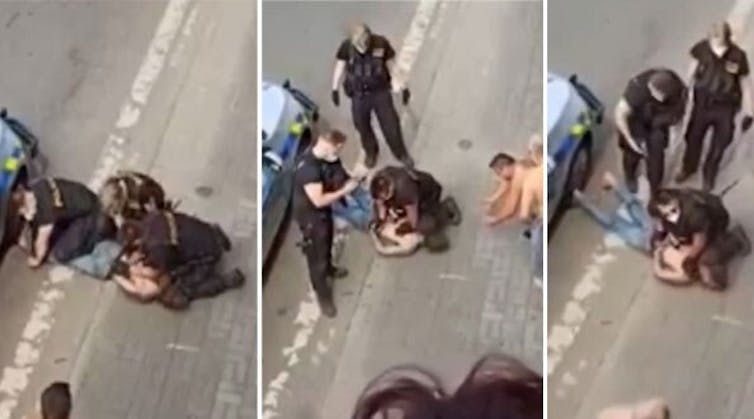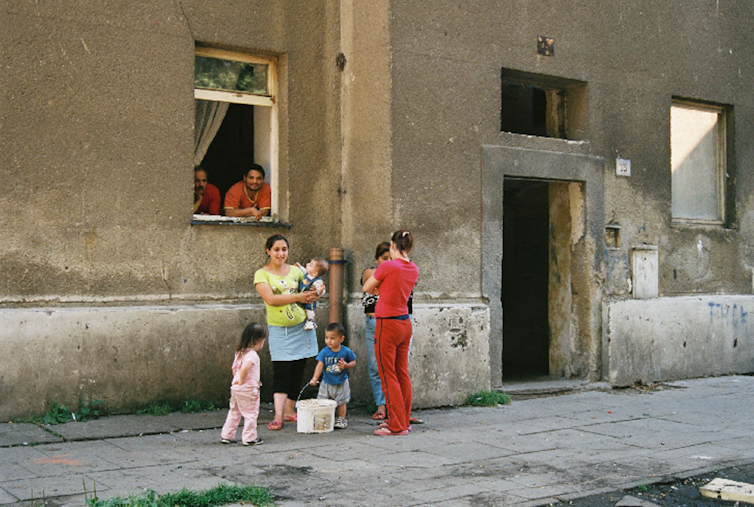![]()

YouTube/ROMEA TV
Dana Brablec, Bangor University
Video footage from Teplice in the Czech Republic which appears to show a police officer kneeling on the neck of a man who subsequently died has been widely shared on social media. The man, who has been named – mainly by international media – as Stanislav Tomáš, has been identified as a member of the Czech Republic’s Roma minority.
The clip appears to show three police officers restraining Tomáš, who is in clear distress, on the pavement. One officer holds Tomáš’s feet, another appears to kneel on his neck, and a third tries to handcuff him. The numerical superiority of police officers and the seemingly disproportionate use of force have led to inevitable parallels with the death of George Floyd, the black American man murdered in 2020 by former police officer Derek Chauvin who kneeled on his neck for several minutes in Minneapolis.
According to Daniel Vítek, spokesman for the Czech police, the procedure of kneeling on the neck was necessary to immobilise a violent man and prevent further damage to private property. To deflect focus onto their victim, the police published images of the same man hitting his head twice against a parked car.
Consequently, using their official Twitter account, the Czech police stated that this case is not a “Czech George Floyd” but a death resulting from a drug overdose. Czech prime minister, Andrej Babiš, said through his Facebook account: “Thank you, Teplice policemen, for your work, they did not have it easy.” The interior minister, Jan Hamáček, meanwhile stated on Twitter: “The policemen who intervened have my full support.”
But members of the Government Council for Roma Minority Affairs criticised Babiš’s and Hamáček’s statements for undermining confidence and impartiality and demanded an independent investigation.
The international community has also joined in the criticism, as Amnesty International and the Council of Europe are questioning the police actions and calling for a thorough and transparent investigation into the events.
Limited outrage
This is not the first time that a Roma citizen of the Czech Republic has died in such circumstances. In 2016, Miroslav Demeter died in the city of Žatec, about 50km from Teplice, after a fight led to the intervention of local police officers. As in Tomáš’s case, a video was recorded showing a local patrol officer kneeling over Demeter while he was immobilised on a restaurant floor. In 2017 the police closed the investigation, stating that Demeter had died as a result of a drug overdose.
Despite the gravity of these circumstances, the death has sparked limited outrage in the Czech Republic or elsewhere, beyond the Roma community.
Two main factors need to be addressed to challenge this indifference: structural racism within the country’s institutions and the lack of Roma integration in society. The latter issue is often treated by politicians as a one-directional problem of self-exclusion and blamed on Roma people themselves.
Structural racism
Roma have lived in the Czech Republic for centuries, but relations with the majority Czech population have always been strained. Because of the deeply rooted racist stigmatisation of Roma as socially “unadaptable”, many Roma have hidden their identity in an attempt to protect themselves from exclusion.
Roma organisations launched a campaign in 2021 encouraging people to declare their Roma identity in the national census. It is generally accepted that they currently number 300,000 people approximately (around 3% of the country’s total population) – although official estimates are lower.
As the European Union Agency for Fundamental Rights has reported, the extent to which anti-Roma racism pervades education, employment, housing and – as potentially suggested by the death of Stanislav Tomáš – policing, is as striking as it is normalised by the majority non-Roma society. This is a clear manifestation of how systemic racism operates in the country. It’s a system in which public policies and institutional practices are combined to create disadvantages against non-white minority groups.

Tomas Vynikal via Shutterstock
Czech Roma have been singled out as unwanted neighbours, with landlords refusing to rent them apartments resulting in their “ghettoisation” in low-standard housing. Similarly, Roma are discriminated against in the labour market and face high unemployment rates. School education of Roma children is based on a modified curriculum that targets impaired children. Meanwhile, hundreds of Roma women were sterilised without their informed consent between 1966 and 2012.
One of the most common expressions of the normalisation of structural racism is its denial and attribution to other social causes. Some may think there are echoes of this in Babiš’s and Hamáček’s statements concerning Tomáš’s death.
Social exclusion
In collaboration with the European Union, the Czech government has been trying to integrate Roma through a series of social projects channelled through civil society organisations. But the government’s expectation for social integration continues to be raised as a one-directional effort, which puts responsibility for integration entirely on the Roma community. Consequently, the idea that Roma are the problem to social adaptation continues to be maintained.
As the initial results of my collaborative WISERD and Bangor University project reveal, most government policies continue to aim for integration of Roma within the mainstream educational, labour and cultural system. But this is without taking into consideration the need for plurality and a society that, at present, acts to marginalise Roma people and put their health, safety and way of life in jeopardy. As a Roma interviewee told me recently: “You are not fully integrated into society if the wider community does not celebrate you.”
Racism is so ingrained in the country’s institutions, especially in law enforcement, that only a long-term government commitment can improve the situation beyond temporary cosmetic measures. One of the first steps to fight against structural racism and advance towards a multi-ethnic society is to recognise and name the real problem. It is not self-exclusion that is the problem, but anti-Roma structural racism.
Dana Brablec, Postdoctoral Research Officer | WISERD – Bangor University, Bangor University
This article is republished from The Conversation under a Creative Commons license. Read the original article.


Be the first to comment